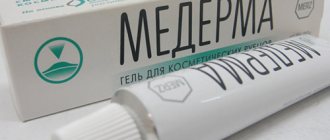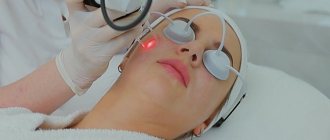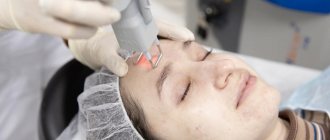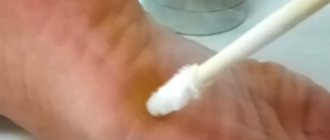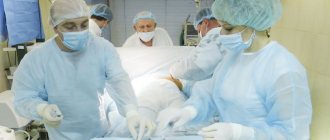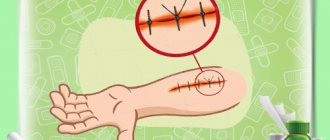Make an appointment with a cosmetologist +7 (3852) 557-557
Leave your phone number and we will call you back
No one is safe from them... A rough scar on your face or body can appear as a result of injury, accident, burn, surgery (for example, to remove appendicitis), cesarean section, acne (so-called “post-acne”), etc. And in the 21st century, scars no longer adorn either men or women. As a result, many people with scars are forced to camouflage them and hide them under clothing for the rest of their lives. But there is another way out! Unsightly scars can be removed using the latest advances in cosmetology and plastic surgery.
Safe
- Natural ingredients
- Suitable for children and pregnant women
- It is not traumatic, unlike laser procedures
The mechanism for correcting stretch marks and atrophic scars
Fermenkol Elactin has a complex effect on the problem area: it destroys scar tissue and restores a healthy skin frame.
Gel Fermenkol S
. Collagenase enzymes destroy the triple helix of pathological collagen in scar tissue to individual amino acids, preparing the skin for the synthesis of a new healthy framework.
Stages of scar formation after surgery
Inflammation and epithalization: 7-10 days
Under favorable conditions, in the absence of infection or divergence of the wound surface, an inconspicuous thin scar is formed. Application of atraumatic sutures, adherence to dressing regime using local antiseptics.
Patients need to limit physical activity and exclude thermal procedures so as not to provoke dehiscence of the wound edges.
Formation of a “young” scar: 10-30 days
Due to the high blood supply to the wound, the scar becomes bright pink. At this stage, the scar is still quite extensible and is easily traumatized.
Restrictions on physical activity remain; it is necessary to prevent secondary damage in the scar area.
Formation of a “mature” scar”: 1-3 months
The scar becomes denser and gradually turns pale. Restrictions on physical activity are lifted. It is important to understand that repeated trauma at this stage increases the risk of developing a keloid or hypertrophic scar.
The mechanism for correcting stretch marks and atrophic scars
Fermenkol Elactin has a complex effect on the problem area: it destroys scar tissue and restores a healthy skin frame.
Gel Fermenkol S. Collagenase enzymes destroy the triple helix of pathological collagen in scar tissue to individual amino acids, preparing the skin for the synthesis of a new healthy framework.
Gel Elactin . Low-molecular hyaluronic acid restores a healthy skin framework, replenishes missing volumes in the post-acne scar area, evens out the relief, normalizes coloring, and adds firmness and elasticity.
Types of scars and features of their formation
The choice of scar correction method depends, first of all, on its type and stage of formation. The fastest and most pronounced results can be achieved when treating fresh scars no older than 1 year. In other cases, surgery may be required to achieve the desired effect.
Normotrophic scars
They are at the same level with the skin, have a pale or close to flesh color, and the degree of elasticity is close to healthy tissues. Medicinal methods of correction can be used. incl. chemical peels.
Atrophic scars
Formed due to insufficient formation of connective tissue, they are located below the skin level. Complex treatment is required, a combination of medication, surgery and hardware (laser) techniques.
Hypertrophic scars
They are formed due to excessive formation of connective tissue and protrude above the surface of the skin. The best result, as a rule, comes from surgical excision of the scar. Often complex treatment is required, which may include medications and hardware (laser) techniques.
Keloid scars
They are formed as a result of pathological changes in the structure of scar tissue. They maintain a tendency to grow for several years. As a rule, they cause not only aesthetic, but also physical discomfort - the formation and growth of a keloid scar is accompanied by itching, burning and pain. Treatment requires a strictly individual approach, based on the medical history and characteristics of the patient’s body. The treatment program may include both surgical and medicinal methods for correcting scar changes.
Laser effect
Molecular biologists of the Fermenkol brand have developed a unique transdermal formula Nanotrop SA (RF patent No. 2462265), which reversibly increases the permeability of the stratum corneum, epidermis and dermis. The active components of Fermenkol Elactin, like a laser, easily penetrate the entire depth of the problem area, destroy deformed skin fibers and accelerate cell regeneration.
As a result, the skin is renewed up to 90%!
How to enhance the effect of Fermencol Elactin
Phonophoresis and electrophoresis enhance the effect of the active components of Fermenkol S and Elactin gels, due to which deformed skin fibers are replaced more quickly with healthy tissue.
Fermenkol Elactin kit with Nevoton device
They trust us
Fermenkol Elactin is successfully used in leading aesthetic medicine clinics
- St. Petersburg Institute of Beauty, Moscow, St. Petersburg.
- Beauty Institute on Arbat, Moscow.
- Institute of Plastic Surgery and Cosmetology, Moscow.
- Irina Khrustaleva Plastic Surgery Clinic, St. Petersburg.
Find out which method of correcting scars and stretch marks is optimal for you!
doctor Svetlana Viktorovna Ogorodnikova.
doctor
Results and discussion
During the comparative analysis of the first stage of the study of gene polymorphisms, a statistically significant difference in the distribution of alleles of the genes Col1A2, MMP3, ESR1, MMP1, MMP7
between the two groups of patients (Fig. 3).
Rice.
3. Average code value of alleles of genes Col1A2, MMP3, ESR1, MMP1, MMP7 in groups A and B. Group A (22 patients diagnosed with acne complicated by atrophic scars):
- Col1A2
— allele code 3 was determined in 17 (77.2%) patients, allele code 2 in 3 (13.6%), allele code 1 in 2 (9.1%);
- MMP3
- allele code 3 was determined in 19 (86.4%) patients, allele code 2 - in 2 (9.1%), allele code 1 - in 1 (4.5%);
— ESR1
- allele code 3 was determined in 8 (36.3%) patients, allele code 2 - in 12 (54.5%), allele code 1 - in 2 (9.1%);
- MMP1
- allele code 3 was determined in 6 (27.2%) patients, allele code 2 - in 14 (63.6%), allele code 1 - in 2 (9.1%);
- MMP7
- allele code 3 was determined in 8 (36.3%) patients, allele code 2 - in 13 (59.1%), allele code 1 - in 1 (4.5%).
Group B (21 patients diagnosed with acne):
- Col1A2
— allele code 3 was determined in 2 (9.5%) patients, allele code 2 in 3 (14.2%), allele code 1 in 16 (76.1%);
- MMP3
- allele code 3 was determined in 5 (23.8%) patients, allele code 2 - in 7 (33.3%), allele code 1 - in 9 (42.8%)
— ESR1
- allele code 3 was determined in 1 (4.7%) patient, allele code 2 - in 2 (9.5%), allele code 1 - in 18 (85.7%);
- MMP1
— allele code 3 was determined in 6 (28.5%) patients, allele code 2 in 5 (23.8%), allele code 1 in 10 (47.6%);
- MMP7
— allele code 3 was determined in 2 (9.5%) patients, allele code 2 in 4 (19.1%), allele code 1 in 15 (71.4%).
Moreover, in patients of group A, the average value of the allele code of the Col1A2
was 2.8 ± 0.1 (
p
< 0.01),
MMP3
- 2.9 ± 0.1 (
p
< 0.01),
ESR1
- 2.1 ± 0.1 (
p
< 0.01 ),
MMP1
- 2.3±0.1 (
p
<0.01),
MMP7
- 2.0±0.1 (
p
<0.01).
In patients from group B, the average allele code of the Col1A2
was 1.3±0.1 (
p
<0.01),
MMP3
- 1.6±0.1 (
p
<0.01),
ESR1
- 1.2±0.1 (
p
<0.01 ),
MMP1
- 1.5±0.1 (
p
<0.01),
MMP7
- 1.4±0.1 (
p
<0.01).
Accordingly, in group A there was a high value of the allele code of the genes Col1A2, MMP3
, the average code value of the alleles of the genes
ESR1, MMP1, MMP7
, at the same time, low values of the alleles of the same genes in group B are shown. At the same time, when analyzing polymorphisms of the
Col1A1, Col3A1, Col5A1, MMP12, MMP2
, no statistically significant difference in the distribution of alleles was revealed of these genes between the study groups of patients. Thus, based on the results of the study, it can be assumed that there are certain genetic predictors of the formation of atrophic post-acne scars.
At stage II of the study, the preventive and therapeutic effectiveness of a fixed combination of 0.1% adapalene/2.5% benzoyl peroxide in patients with post-acne was assessed.
In group 1, during the use of a fixed combination, not a single clinical case showed a relapse of the disease, which indicates the preventive nature of the drug. With regard to post-acne symptoms, a pronounced positive trend was observed: post-inflammatory erythema decreased by 85%, pigmentation resolved by 70%, the morphological structure of scars, their relief and number decreased by 56.1% (largely due to scars of mild and moderate severity) ( Fig. 4).
Rice. 4. General assessment of the clinical symptoms of acne and post-acne at baseline, after 3 and 6 months in patients of group 1.
In group 2, by the 3rd month, 15.4% of patients noted the appearance of new single inflammatory elements (papules, pustules). Significant changes in post-inflammatory erythema and pigmentation were observed only by the 6th month, but the severity of these symptoms decreased only by 35 and 24%, respectively. The morphological structure of the scars and their relief did not tend to improve; moreover, scars continued to form at the sites of new rashes, and their total number increased (Fig. 5).
Rice. 5. General assessment of the clinical symptoms of acne and post-acne at baseline, after 3 and 6 months in patients of group 2.
A general assessment of the severity of atrophic acne scars was carried out taking into account the SGA scale. After 3 months of using a fixed combination of 0.1% adapalene/2.5% benzoyl peroxide, the number of patients with clear skin increased 2-fold, and the quality characteristics and relief of scar deformities of moderately severe scars improved 1.5-fold. After 6 months, in group 1, the number of patients with an SGA score of “almost clear skin” increased 7-fold, while in group 2 there was no positive dynamics after 3 and 6 months. Thus, the fixed combination of 0.1% adapalene/2.5% benzoyl peroxide has a certain preventive effect regarding the formation of atrophic scars, which was confirmed by the absence of new secondary elements, while the proportion of patients with an SGA rating of “almost clear skin” (barely noticeable scars ) increased from 6.4 to 46.7% when using the combination drug and did not change in the control group (Fig. 6).
Rice. 6. General assessment of the severity of scars, taking into account the indicators of the SGA scale at baseline, after 3 and 6 months in patients of both groups.
Comparison of the use of Fermenkol Elactin and laser procedures
According to a number of cosmetologists and dermatologists, the effectiveness of Fermenkol Elactin in the fight against stretch marks and atrophic scars is comparable to laser procedures. However, Fermenkol Elactin has a number of advantages.
Why don’t conventional remedies help with stretch marks and atrophic scars?
Stretch marks (striae) are a special type of atrophic scars. To get rid of them, it is necessary to destroy pathological scar tissue and restore a healthy skin framework. Therefore, simple moisturizing and nourishing products cannot help correct stretch marks and atrophic scars.
You can purchase all Fermenkol products in our online store
Order online
Material and methods
At the first stage of our study, 43 women aged 15 to 27 years with established diagnoses of acne and acne complicated by atrophic scars were observed. All patients, depending on the clinical picture, were divided into two comparable groups: group A included 22 patients (acne complicated by atrophic scars) and group B - 21 (acne). All patients underwent buccal scraping with sterile cotton swabs to collect material for analysis, followed by a genetic study of the frequency distribution of gene polymorphisms ESR1, Col1A1, Col1A2, Col3A1, Col5A1, MMP1, MMP12, MMP2, MMP3, MMP7
.
The study results were assessed on a 3-point scale:
1 — homozygote frequent allele (norm/norm), which corresponds to the absence of an increased risk of developing the trait under study (average population risk);
2 - heterozygote (normal/mutation), which corresponds to a moderate risk of developing the trait under study;
3 - homozygous rare allele (mutation/mutation), which corresponds to a significant risk of developing the trait under study (the gene for this trait is a risk factor for the disease).
At stage II of the study, 50 patients were observed - 28 (56%) men and 22 (44%) women with severe acne, whose average age was 15.7 ± 1.4 years. As the main treatment, participants received a systemic retinoid (isotretinoin) in standard dosages (initial dose - 0.7-0.8 mg/kg/day, followed by a dose reduction to 0.4-0.5 mg/kg/day, course duration at least 6 months). After achieving IGA 0-1, patients with atrophic post-acne scars were divided into two groups: group 1 included 24 patients, group 2 - 26. Patients of group 1, after completing the course of treatment with isotretinoin, used the drug externally with a fixed combination of 0 .1% adapalene/2.5% benzoyl peroxide once a day for 6 months. Patients of group 2 did not receive any treatment. The clinical picture in patients of groups 1 and 2 was represented by atrophic scars, post-inflammatory pigmentation and foci of congestive erythema. The effectiveness was assessed taking into account the number of primary elements of acne and atrophic post-acne scars (5-point system of severity for each element of the rash on a visual analogue scale), as well as an overall assessment of the severity of scars (Scar Global Assessment - SGA).
Laser removal (modification) of scars of any origin: quickly, effectively and painlessly!
The statement that scars are decoration is irrelevant today, because the standard of beauty in the modern world is people with well-groomed, smooth and delicate skin.
However, if unusual life circumstances, past illnesses or surgical intervention have left unpleasant memories on your skin in the form of scars and cicatrices, you can get rid of them using laser resurfacing and other methods of restoring the structure of the upper layers of the epidermis. The State Scientific Center for Laser Medicine will help you realize your dream of beautiful, scar-free skin, using innovative laser equipment and using leading scar removal methods.
Qualified specialists of our beauty center will relieve you of fresh or old scars, be it:
- post-acne
- keloid scars
- stretch marks (striae)
Experienced staff will select for you an individual method of laser removal of scars and scars.


